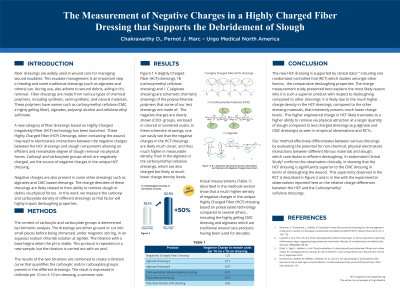Laboratory Research
(LR-008) The Measurement of Negative Charges in a Highly Charged Fiber Dressing That Supports Debridement of Slough

Fiber dressings are currently used materials for wound contact in the desloughing of chronic wounds, an important step in healing, and are made of different chemical composition fibers, such as carboxymethyl cellulose (CMC, a highly gelling fiber), alginate, polyvinyl alcohol and cellulose ethyl sulfonate. A new category of fiber dressings based on highly charged (negatively) unique polyacrylate technology has been launched. When contacting the wound, electrostatic interactions between the negative charges in these Highly Negatively Charged (HCF) dressings and slough components allowing slough removal via physical forces. Carboxyl and carboxylate groups which are negatively charged, are the source of negative charges in the unique HCF dressing. Negative charges are also also present in some others such as alginates and CMC based dressings. In this work, we measure the carboxyl and carboxylate density of different dressings as that will highly impact desloughing properties.
Methods:
The content of carboxylic and carboxylate groups is determined by titrimetric analysis. The dressings are either ground or cut into small pieces before being immersed, under magnetic stirring, in an aqueous sodium chloride solution at 5g/liter. The titration with NaOH begins when the pH is stable. This protocol is repeated on a new sample, but the titration is carried out with HCl.
The results of the two titrations are combined to create a titration curve that quantifies the carboxylic and/or carboxylate groups present in the different dressings. The result is expressed in milliequivalent per gram of dressing.
Results:
We show a much higher density of negative charges in the unique Highly Charged Fiber dressing based on polyacrylate technology compared to others, including the highly gelling CMC dressing and alginates.
Discussion:
The HCF dressing is supported by clinical data in comparative desloughing studies. This probing study explains the most likely reason why it is such a superior product with respect to desloughing compared to other dressings that possess much lower charge levels. Our method clearly allows discrimination between different dressings in terms of the potential of electrostatic interactions of different fibrous materials with the slough which leads to effective desloughing.

.jpg)